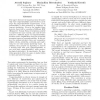Free Online Productivity Tools
i2Speak
i2Symbol
i2OCR
iTex2Img
iWeb2Print
iWeb2Shot
i2Type
iPdf2Split
iPdf2Merge
i2Bopomofo
i2Arabic
i2Style
i2Image
i2PDF
iLatex2Rtf
Sci2ools
AAAI
1993
1993
Comprehensibility Improvement of Tabular Knowledge Bases
This paper discusses the important issue of knowledge base comprehensibility and describes a technique for comprehensibility improvement. Comprehensibility is often measured by simplicity of concept description. Even in the simplest form, however, there will be a number of di
erent DNF (Disjunctive Normal Form) descriptions possible to represent the same concept, and each of these will have a di
erent degree of comprehensibility. In other words, simpli
cation does not necessarily guarantee improved comprehensibility. In this paper, the authors introduce three new comprehensibility criteria, similarity, continuity, and conformity, for use with tabular knowledge bases. In addition, they propose an algorithm to convert a decision table with poor comprehensibility to one with high comprehensibility, while preserving logical equivalency. In experiments, the algorithm generated either the same or similar tables to those generated by humans.
AAAI 1993 | Di Erent Dnf | Intelligent Agents | Knowledge Base Comprehensibility | Knowledge Bases |
| Added | 02 Nov 2010 |
| Updated | 02 Nov 2010 |
| Type | Conference |
| Year | 1993 |
| Where | AAAI |
| Authors | Atsushi Sugiura, Maximilian Riesenhuber, Yoshiyuki Koseki |
Comments (0)

